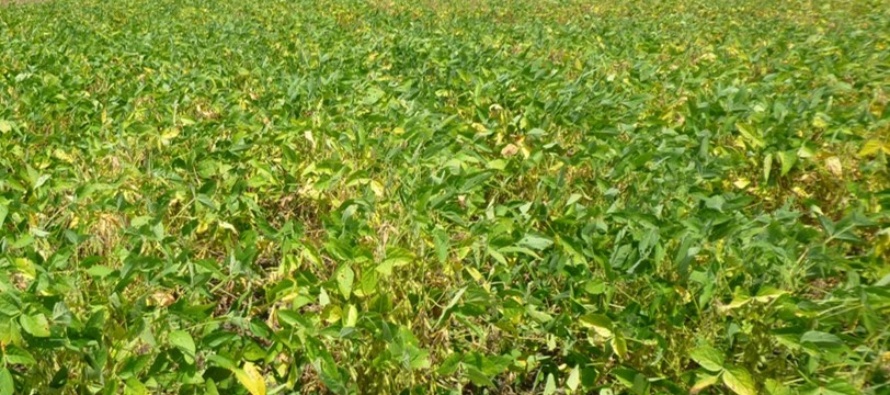Soybean Harvest Aids

Related Articles
- 2010 Soybean And Corn Variety Trial Data 3
- Rice Variety Trial Results For 2010, Plus Rice Research Report 0
- Evaluation of Peanut Prescription Rx Program in Mississippi 0
Latest Tweets
 As of August 14, the USDA National Agriculture Statistics Service reports 31% of Mississippi soybean acreage is changing color with 5% of the acres dropping leaves. Several calls have come in over the last week regarding soybean harvest aid options for various scenarios. Following the weather patterns that many areas of the state have experienced over the last couple of weeks, one issue of concern is seed sprouting in pods. This premature sprouting will result in damage to the grain quality. There are various factors that can cause this issue. Given the stage of crop development and the timing of the wet weather, it is likely that the expanding seed caused the pod walls to separate from one another allowing moisture to enter the seed. In this scenario, a harvest aid may be beneficial to expedite harvest and minimize additional damage from sprouting seed. Be mindful that a fungicide application will not protect the soybean from sprouting in the pod as this situation is due to moisture and not the result of a specific foliar disease. However, maintaining seed quality when threatened by mold, or several other potential factors based on the grain grading categories are a different subject. Keep in mind that careful consideration should be given to the stage of development of the crop. If the majority (65%) of the pods in the field are mature with the remaining pods having seed completely separated from the pod wall, it is safe to apply a harvest aid.
As of August 14, the USDA National Agriculture Statistics Service reports 31% of Mississippi soybean acreage is changing color with 5% of the acres dropping leaves. Several calls have come in over the last week regarding soybean harvest aid options for various scenarios. Following the weather patterns that many areas of the state have experienced over the last couple of weeks, one issue of concern is seed sprouting in pods. This premature sprouting will result in damage to the grain quality. There are various factors that can cause this issue. Given the stage of crop development and the timing of the wet weather, it is likely that the expanding seed caused the pod walls to separate from one another allowing moisture to enter the seed. In this scenario, a harvest aid may be beneficial to expedite harvest and minimize additional damage from sprouting seed. Be mindful that a fungicide application will not protect the soybean from sprouting in the pod as this situation is due to moisture and not the result of a specific foliar disease. However, maintaining seed quality when threatened by mold, or several other potential factors based on the grain grading categories are a different subject. Keep in mind that careful consideration should be given to the stage of development of the crop. If the majority (65%) of the pods in the field are mature with the remaining pods having seed completely separated from the pod wall, it is safe to apply a harvest aid.
A greater application volume is generally suggested when making a harvest aid application in soybean as coverage is essential. Also, keep in mind that each of the products available for use as a harvest aid in soybean has a specific preharvest interval that may influence the timing of an application. Check the weather forecast before making the application and, if the decision to utilize a harvest aid is made, then be prepared to harvest as soon as this interval has passed.
The following products are labeled for use as a harvest aid in soybean:
Aim EC at 1 to 1.5 fl oz/acre
Generally speaking, this product will be better on vines (morningglory, redvine, etc.) than on other weeds. Aim EC is labeled in soybean and will not likely have significant effect as a desiccant for the crop. A nonionic surfactant (0.25% V/V) or crop oil concentrate (1% V/V) should be included. Keep in mind that there is a 3 day preharvest interval if this product is used as a harvest aid.
paraquat at 8 to 16 fl oz/acre
Paraquat will provide desiccation of both weeds and soybean. The preferred application rate is 0.25 lb ai/acre. A nonionic surfactant (0.25% V/V) should be included. For paraquat, a 15 day preharvest interval is required.
Sharpen at 1 to 2 fl oz/acre
Sharpen will provide desiccation of broadleaf weeds and soybean. The addition of a methylated seed oil (1% V/V) plus ammonium sulfate (1 to 2% W/V) is recommended for optimum desiccation. Application rates of 1.5 to 2 fl oz/acre are generally required when Sharpen is applied alone. This product has a 3 day preharvest interval.
sodium chlorate at 3 to 6 lb ai/acre
Sodium chlorate will also provide desiccation of weeds and soybean. However, the level of activity from this application will depend on environmental conditions at the time of application. In situations where excessive grass pressure is present, a tank-mix of paraquat at 0.25 lb ai/acre + sodium chlorate at 3 lb ai/acre may help to dry the grassy weeds down to prepare for harvest. One thing to keep in mind is that sodium chlorate is a true desiccant and will physically draw moisture out of plant tissues and seed. Therefore, an increased potential for shattering exists and harvest should occur in a timely manner. Sodium chlorate should be applied 7 to 10 day before harvest.
More specific information about these and other products for use as harvest aids in soybean can be found in the 2016 Weed Control Guidelines for Mississippi.




Let me tell You a sad story ! There are no comments yet, but You can be first one to comment this article.
Write a comment